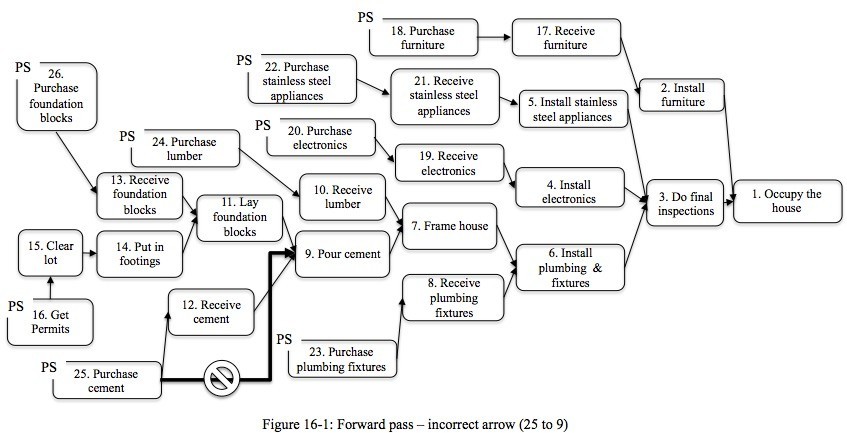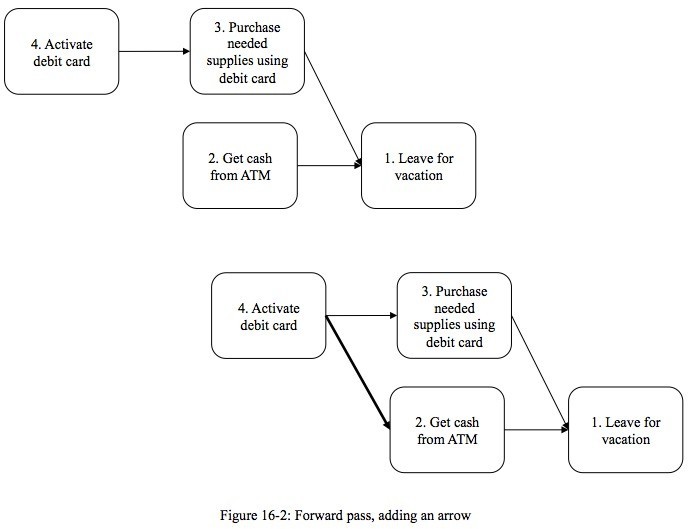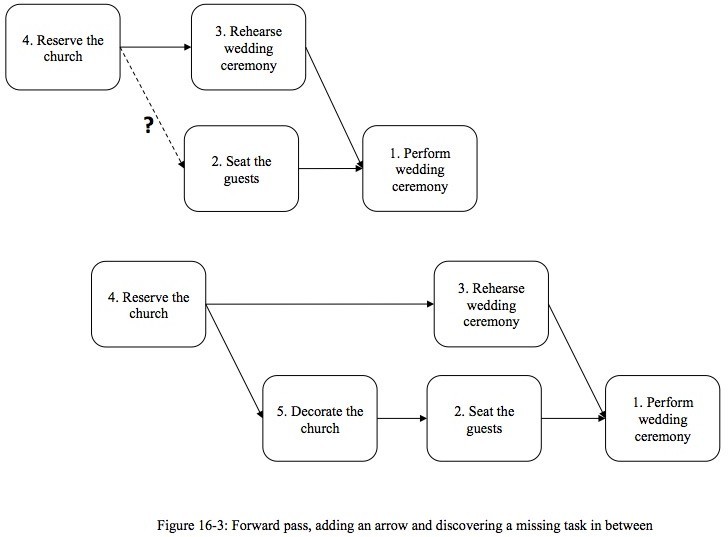by Kathleen Austin & Gerald Kendall

Part 1 provided an introduction to projects and the need to plan a project. Part 2 discussed how to ensure the correct level of detail in a project network. Parts 3 – 5 detailed Steps 1 – 3 of the 10 steps to building an executable project plan. Basis for this post: Advanced Multi-Project Management: Achieving Outstanding Speed and Results with Predictability, by Gerald I. Kendall and Kathleen M Austin, J. Ross Publishing, 2012, Chapter 16.
Step 4: Define additional dependencies
One type of chaos that occurs when executing projects is to assign a resource to a task, only to discover after starting the task that some prior task’s output was needed and is not ready. The resource manager had scheduled to use that resource in order to ensure that the project continues progressing. Now, the resource manager has two problems to overcome – first, what to do with this resource, and secondly, when will I actually be able to assign this task and what impact will this have on the project. If this happens once a month, everyone can live with this. But if project network teams do not follow step 4 in the network building process, this type of chaos could well become a daily occurrence. Step 4 significantly reduces this risk.
Finding Additional Task Dependencies
Step 4 is the forward pass of building the project network. Specifically, it is reading the network forward, from the beginning, rigorously looking for missed additional task dependencies. In our analogy to home building, it is like saying “This wall must be built before the fireplace goes in upstairs because it is a load bearing wall for the fireplace. But we never noted before that this is also a load bearing wall for the indoor hot tub. We better make sure that this wall is complete before we move in the hot tub!” This is the first risk avoidance in that we are ensuring that no tasks will be started, during project execution, with missed dependencies.
Before beginning this step, ensure all previous steps have been completed; the tasks, dependencies, and all required notes have been entered into the computer; and a fresh plot / printout of the network diagram is available.
Pick one path start task (denoted by “PS”). You will see that it is already connected to one or more successor tasks. Ask, “Is the output of (this task) needed to begin any other task (for which we have not shown the arrow or dependency)?” An alternative wording would be “What other task cannot start without the output of this task?”
The two keys to this step are to
- Identify any missing inputs and
- Ensure no incorrect inputs are
See below for an example of an incorrect input. There already is a pathway from Task 25 through Task 12 to Task 9. Adding an arrow from Task 25 directly to Task 9 is incorrect because the output of 25 (purchased cement) is not the immediate input for Task 9; the cement must be received (Task 12) before it can be poured (Task 9). The key is to show the correct flow of work as it is passed along the arrow!
 Continue along this pathway, using the checking wording above and a colored pencil to help identify the pathways completed, until you reach the last task on the right of the project.
Continue along this pathway, using the checking wording above and a colored pencil to help identify the pathways completed, until you reach the last task on the right of the project.
Continue the process, going back to an unchecked path start task, until the forward pass has been accomplished for the entire project network.
As the forward pass is being accomplished, there are two typical modifications that are made to the project network:
- Adding an additional arrow going to another task on the right from an existing task on the left. This means that the output of the task on the left is required as an input to an additional task not previously identified. For example, the output of Task 4 below is an activated debit card. An activated debit card is needed to purchase supplies (Task 3), as shown by the existing arrow in the upper part of the example. An activated debit card is
also needed in order to withdraw cash from the ATM (Task 2), so the new arrow is drawn from Task 4 also to Task 2.
 When it looks like there should be an arrow from one task to another (below, from Task 4 to Task 2), but the output of one is not the IMMEDIATELY required input of the other, it is likely that there is a task missing between the two. It seems that “Reserving the church” must be an input to “Seating the guests”. Otherwise where would you seat the guests for the wedding ceremony? But the church reservation (output of Task 4) is not what is required in order to begin seating the guests. However, reserving the church is an input to decorating the church (Task 5) and decorating the church is an input to seating the guests (Task 2). So in this example, the forward reading of the network has helped identify the missing task and arrows, as shown.
When it looks like there should be an arrow from one task to another (below, from Task 4 to Task 2), but the output of one is not the IMMEDIATELY required input of the other, it is likely that there is a task missing between the two. It seems that “Reserving the church” must be an input to “Seating the guests”. Otherwise where would you seat the guests for the wedding ceremony? But the church reservation (output of Task 4) is not what is required in order to begin seating the guests. However, reserving the church is an input to decorating the church (Task 5) and decorating the church is an input to seating the guests (Task 2). So in this example, the forward reading of the network has helped identify the missing task and arrows, as shown.

Step 4 is not complete until all pathways have had the forward pass performed.
Tips
- Do not add extra, incorrect If tempted, ask yourself if the output of the task on the left is needed in the exact same form/format as an input for the candidate task on the right.
- Colored pencils can be useful for indicating where you have and have not done the forward pass on your They can also help highlight when you’ve accidently created an extra incorrect pathway.
- This is not a step used to dive into deeper detail in the This step’s only purpose is to identify missing dependencies.
Conclusions
Every project encounters some surprises during execution. The fewer the surprises, the more likely all projects will complete on time, on budget and within scope. While some surprises are unavoidable, this chapter helps eliminate or at least drastically reduce the surprises from
missed task dependencies. This is the kind of surprise where a resource starts a task, only to find that they needed the output of another task in order to progress on the current task. This could mean that they encounter a wait period, forcing them to multitask on some other task, or they have rework on the current task. Further, the completion of the task is delayed and this forces resource managers to waste precious time rescheduling. Step 4 of the network building process avoids this risk by having the team read the network from beginning to end, rigorously looking for these missing task dependencies.
Next Post
- Step 5: Check the network against project goals, scope, and



